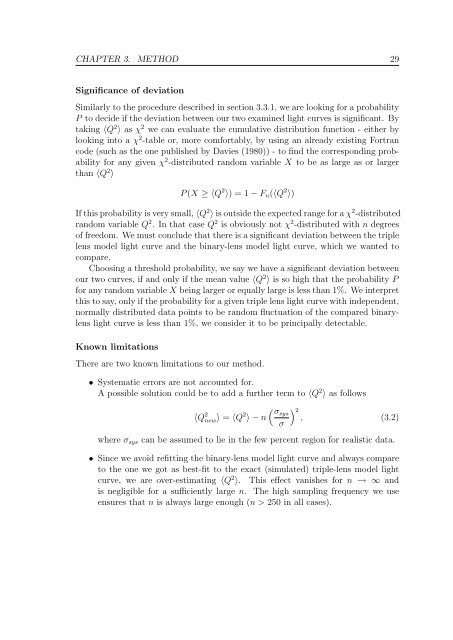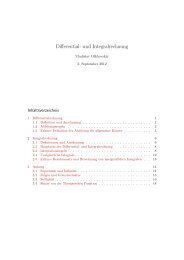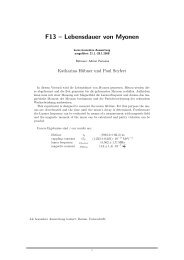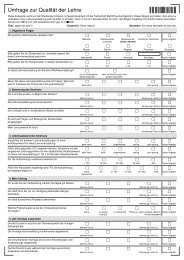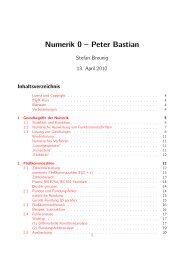Extrasolar Moons as Gravitational Microlenses Christine Liebig
Extrasolar Moons as Gravitational Microlenses Christine Liebig
Extrasolar Moons as Gravitational Microlenses Christine Liebig
Create successful ePaper yourself
Turn your PDF publications into a flip-book with our unique Google optimized e-Paper software.
CHAPTER 3. METHOD 29<br />
Significance of deviation<br />
Similarly to the procedure described in section 3.3.1, we are looking for a probability<br />
P to decide if the deviation between our two examined light curves is significant. By<br />
taking 〈Q 2 〉 <strong>as</strong> χ 2 we can evaluate the cumulative distribution function - either by<br />
looking into a χ 2 -table or, more comfortably, by using an already existing Fortran<br />
code (such <strong>as</strong> the one published by Davies (1980)) - to find the corresponding probability<br />
for any given χ 2 -distributed random variable X to be <strong>as</strong> large <strong>as</strong> or larger<br />
than 〈Q 2 〉<br />
P (X ≥ 〈Q 2 〉) = 1 − Fn(〈Q 2 〉)<br />
If this probability is very small, 〈Q 2 〉 is outside the expected range for a χ 2 -distributed<br />
random variable Q 2 . In that c<strong>as</strong>e Q 2 is obviously not χ 2 -distributed with n degrees<br />
of freedom. We must conclude that there is a significant deviation between the triple<br />
lens model light curve and the binary-lens model light curve, which we wanted to<br />
compare.<br />
Choosing a threshold probability, we say we have a significant deviation between<br />
our two curves, if and only if the mean value 〈Q 2 〉 is so high that the probability P<br />
for any random variable X being larger or equally large is less than 1%. We interpret<br />
this to say, only if the probability for a given triple lens light curve with independent,<br />
normally distributed data points to be random fluctuation of the compared binarylens<br />
light curve is less than 1%, we consider it to be principally detectable.<br />
Known limitations<br />
There are two known limitations to our method.<br />
• Systematic errors are not accounted for.<br />
A possible solution could be to add a further term to 〈Q 2 〉 <strong>as</strong> follows<br />
〈Q 2 new〉 = 〈Q 2 〉 − n<br />
<br />
σsys<br />
2<br />
, (3.2)<br />
σ<br />
where σsys can be <strong>as</strong>sumed to lie in the few percent region for realistic data.<br />
• Since we avoid refitting the binary-lens model light curve and always compare<br />
to the one we got <strong>as</strong> best-fit to the exact (simulated) triple-lens model light<br />
curve, we are over-estimating 〈Q 2 〉. This effect vanishes for n → ∞ and<br />
is negligible for a sufficiently large n. The high sampling frequency we use<br />
ensures that n is always large enough (n > 250 in all c<strong>as</strong>es).


